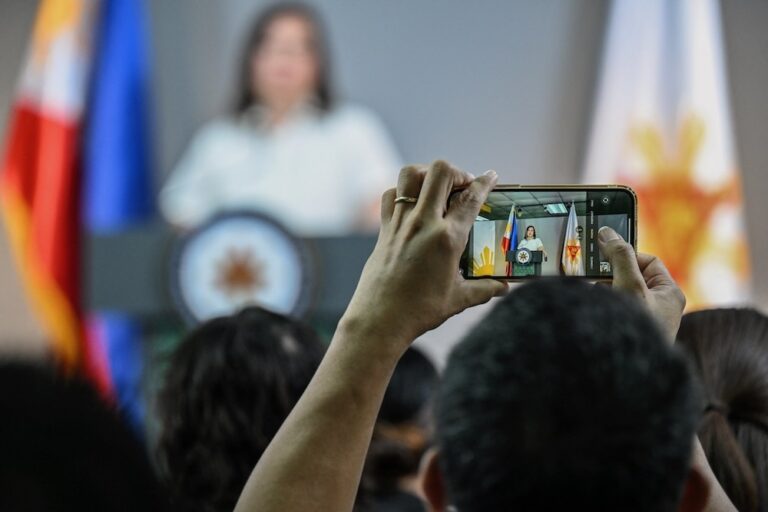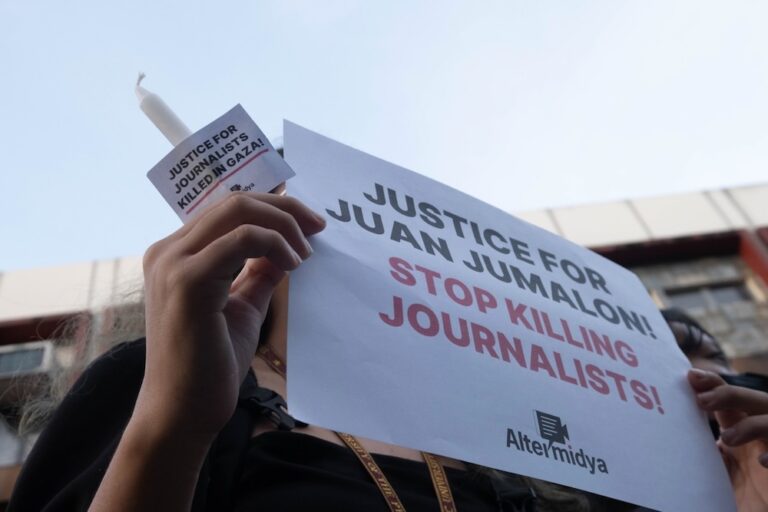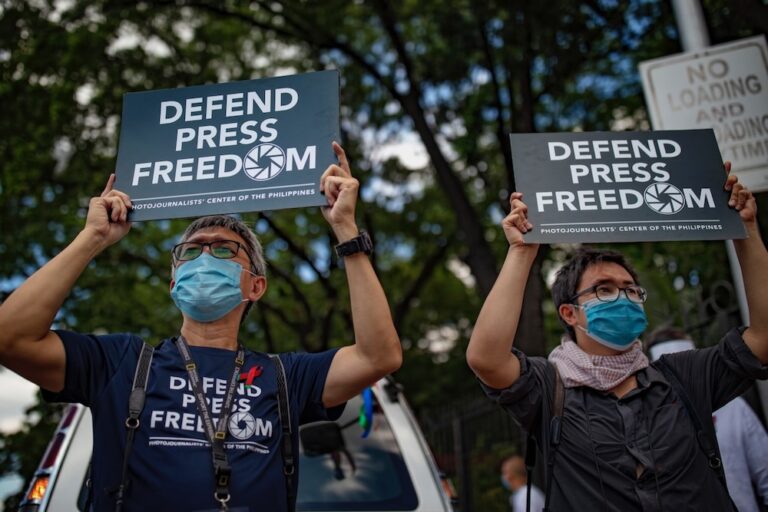Red-baiting incidents against media practitioners have worsened under the Duterte administration.
This statement was originally published on cmfr-phil.org on 20 September 2019.
To the many perils of truth-telling in the Philippines, where 165 journalists have been killed for their work since 1986, and hundreds more threatened, physically assaulted, and sued for libel to silence them, the Duterte regime has added that of red-baiting.
More popularly known as “red-tagging,“ it is a form of harassment against critics of government that has also targeted journalists who have either been critical in their reporting or commentary on public issues, or who have simply tried to get at the truth in observance of a fundamental ethical and professional responsibility. Red-baiting can lead to journalists’ being harmed or even killed – and all evidence suggests that it is government orchestrated.
In August 2019, Leonardo Vicente “Cong” Corrales, an associate editor of the Mindanao Gold Star Daily, and Froilan Gallardo, a photojournalist for the online news site MindaNews and himself a correspondent of Gold Star Daily, were accused by unknown sources of having links with the Communist Party of the Philippines (CPP) and its armed component, the New People’s Army (NPA).
Both Corrales and Gallardo are based in Cagayan de Oro. A packet of “information” also falsely claimed that Corrales was wanted for the rape and murder of a nine-year-old child, and that he had a PHP1 million bounty on his head.
It was the latest in a series of red-baiting incidents against media practitioners under the Duterte administration, the numbers of which have steadily increased as the peace talks between the peace panels of the GPH (Government of the Philippines) and the CPP-NPA-NDF (Communist Party of the Philippines – New People’s Army – National Democratic Front) were disrupted by continuing incidents of firefights and other forms of violence between the Philippine military and the NPA. President Duterte announced that he had decided to permanently stop the peace negotiations with the Left in March 2019 that he himself had initiated in 2016.
A joint petition asking for the protection of the journalists and others similarly red-baited has been filed before the Cagayan de Oro City council by the National Union of Journalists of the Philippines (NUJP), the Union of People’s Lawyers in Mindanao (UPLM), the Kalipunan ng Damayang Mahihirap (Kadamay-Mutual help, an urban poor organization), Makabayang Koalisyon ng Mamamayan (Makabayan – Patriotic Citizens’ Coalition), and the Iglesia Filipina Independiente (IFI – The Philippine Independent Church). The city council has also formed a technical working group to study the petition. The NUJP said it is planning to file a report with the UN Special Rapporteur on the Promotion and Protection of the Right to Freedom of Opinion and Expression.
Definition
“Red-tagging” is the same as red-baiting, which in the Philippines refers to acts that publicly identify people as linked to the CPP, the NPA or the NDF. In many cases, the individual is not accused of actual membership in the CPP but is simply alleged to have links with so-called “fronts,” or organizations that the military says are part of the “legal infrastructure” of the CPP-NPA-NDF. The practice goes back to the late 1950s, when membership in the Communist Party was illegal in the Philippines, and to the McCarthy period in the United States, when Republican Senator Joseph McCarthy accused even officials of the US State Department of being communists on no other evidence than his say-so.
In his 2015 dissenting opinion on the Amparo petition filed by several members of party-list groups before the Supreme Court that was denied by the majority, Associate Justice Marvic Leonen thus described red-baiting as “our version of McCarthyism.”
“As stated by (UN Special Rapporteur Philip) Alston, it is the “‘vilification,’ ‘labelling’, or guilt by association” of various democratic organizations. These groups are stereotyped or caricatured by the military as communist groups, making them easy targets of government military or paramilitary units,” Leonen wrote. Red-baiting makes those so identified as vulnerable to attacks, and “a chilling effect on dissent is also generated among similar-minded individuals,” he added.
Background
The government’s approach to the CPP has evolved through the years, reflecting the changing political environment under different administrations.
In 1957, with the Hukbong Mapagpalaya ng Bayan (HMB-People’s Liberation Army) active in Central Luzon, Congress passed Republic Act 1700, which declared the Communist Party of the Philippines an “organized conspiracy to overthrow the government,” and made membership in the CPP punishable with imprisonment. The HMB was essentially defeated in the late 1950s and the CPP leadership captured and imprisoned.
In a demonstration of the truth that rebellion and social unrest cannot be stopped without addressing their roots, the Communist Party of the Philippines was “reestablished” in 1968, and the New People’s Army organized from the remnants of the HMB in 1969. Armed with dictatorial powers upon his declaration of martial law in 1972, Ferdinand Marcos issued Presidential Decree 885 in 1976, declaring as illegal “any association, organization, or groups of persons organized for the purpose of overthrowing the government.” Mere membership in such an organization or anything similar was punishable with imprisonment, disqualification from public office, and forfeiture of the right to vote.
In 1981, Marcos’ Presidential Decree 1835 further increased the penalties for membership in “subversive” organizations. President Corazon Aquino repealed PD 1835 in 1987, but issued Executive Order 167 reviving RA 1700, again outlawing membership in the CPP.
During the term of President Fidel Ramos, Congress passed Republic Act 7636 which revoked EO 167 in 1992. Membership in the CPP has not been illegal since. The 1987 Constitution also recognizes the right of the people to form associations “not contrary to law,” and specifically declares that “no person shall be detained solely by reason of his political beliefs and aspirations.”
The military and the police, however, continue to refer to the Communist Party of the Philippines as “subversive” and uses such terms as “Communist Terrorist” (CT) to describe it in their reports; the latest term is “CNT”, or “CPP-NPA-Terrorist.”
Former UN Special Rapporteur Alston, in his report on the Philippines after his 2007 visit, noted that “many in government have concluded that numerous civil society organizations are ‘fronts’ for the Communist Party of the Philippines and its armed group, the New People’s Army. One response has been counter-insurgency operations that result in the extrajudicial execution of leftist activists.”
Members of civil society organizations associated with the Left and with advocacies focused on protecting and enhancing the rights of marginalized groups such as farmers, indigenous peoples and victims of human rights violations are routinely red-baited, often by the military. As the peace talks with the Left failed, red-baiting has increased, and has even included lawyers who defend political and social activists in court, or who question government policies. Members of alternative media groups such as Bulatlat and Kodao, which are often linked to the CPP-NPA-NDF, have also been red-baited.
Nonoy Espina, national chairperson of the NUJP, noted that there was not much red-baiting at the onset of the Duterte administration. Duterte’s attacks then were mostly limited to Rappler, ABS-CBN, and the Philippine Daily Inquirer, all of which he perceived to be critical of his administration.
Sherwin de Vera, managing editor of the Cordillera-based Northern Dispatch (NorDis), observed that red-baiting incidents surged after the CPP-NPA ended its unilateral ceasefire with the government in February 2017. De Vera was arrested for rebellion in December 2017, and released on bail in January 2018. At the time of his arrest, he was writing for NorDis on environmental issues in the Ilocos region.
De Vera was also included in a list of alleged members of the CPP-NPA-NDF submitted by the Justice Department to a Manila regional trial court in February 2018. The department submitted a petition asking the court to declare the CPP-NPA-NDF as terrorist organizations. In June and July this year, De Vera said NorDis was linked to the NPA. According to De Vera, during a July meeting of a government task force on terrorism, some task force members said “they needed to counter the CNT (Communist-NPA-Terrorist) propaganda of Northern Dispatch.”
The Cagayan de Oro red-baiting/tagging incident
The latest incident of red-baiting/tagging was in Cagayan de Oro, where the two senior media practitioners Cong Corrales and Froilan Gallardo were named in an “information” packet sent to Evelyn Naguio, an employee of the Cagayan de Oro City Hall, and to Rolando Abejo, an Aglipayan (IFI) priest, through the LBC courier company. (see CMFR alert)
The packet sent to Naguio contained a one-page, legal-size sheet of paper on which were pictures of Corrales, and text that alleged he was wanted for the rape and murder of a nine-year-old child. The one sent to Fr. Abejo had his picture and text in which he supposedly identifies himself as “a full-time NPA terrorist.” Gallardo was among those mentioned as “people trusted by the NPA.” The packets were mailed by a Danilo Tirso Mantagan of Sitio Camansi, Lagonglong, Misamis Oriental.
On August 27, a day after Naguio received her packet, an envelope addressed to Corrales was sent to the Cagayan de Oro Press Club; it contained the same leaflet sent to Naguio. LBC records show both packets were sent on the same day from the same LBC branch. The NUJP initially posted the contents of the packets in a report together with their statement but later deleted the allegations in the packets.
Printed under the pictures of Corrales was the following description, as translated from the Visayan language:
“This is Cong Corrales, known as Kumander Butilos under the New People’s Army (NPA). He pretends to be a journalist but is actually paid by Satanas Joma Sison and Satanas Kumander Muling to recruit the youth, destroying their future. He also has a pending rape-slay case at Surigao, RTC Branch 01-1 with criminal case number 2006-2902 where he raped and murdered a 9-year-old which was the reason why he joined the NPA. As of this moment, he is still at large with a reward money of P1,000,000 for his death.”
The leaflet was signed by the fictitious “Black Mamba MAT-NMR Press Club Chapter.”
Gallardo said he had received death threats before, but that this was the first time he had been red-baited. He was among those individuals and groups named as NPA supporters in a streamer hung by unknown individuals on, of all places, the Press Freedom Monument in front of the Cagayan de Oro provincial capitol on May 27, on the first day of the city’s Press Freedom Week this year. Corrales was also on it, together with the NUJP, the National Union of People’s Lawyers (NUPL), and the IFI. NUJP took it down the same day and burned it.
In June, leaflets listing alleged NPA supporters had been found in a box near a busy mall; Corrales and Gallardo were on the list. In July, posters red-tagging NUJP and NUPL were plastered on the walls of the IFI church in Barangay Agusan in Cagayan de Oro City. The posters were signed by the “Movement Against Terrorism-Northern Mindanao Region.”
Earlier in February, Corrales said leaflets listing alleged NPA coddlers were given to a security guard during a press conference of the human rights group Karapatan. Corrales said the list included his wife’s and son’s names.
Corrales believes these attacks may have been triggered by an earlier column in which he wrote about indigenous peoples who, driven out of their communities by military operations, had sought shelter in the provincial capitol, but had been driven away by the local government.
Gallardo also believes the red-tagging against him is work-related, as he would always get the side of the NPA as well as that of the military when writing conflict-related stories, as demanded by the fairness standard of journalism, which requires journalists to report both sides of an issue, unless one side is patently in error.
Saying that the military wanted to look into the incident, a military official has reached out to Corrales, asking for a picture of the posters. NUJP, together with other organizations whose members were also red-tagged, has filed a petition with the Cagayan de Oro City Council asking it to, among others: 1) investigate the incident; 2) issue a resolution condemning red-tagging; 3) pass an ordinance penalizing red-tagging; and 4) direct local officials to remove materials that red-tag people and organizations.
The city council has formed a technical working group to look into the petition and submit recommendations to the city council.
The NUJP has met with the officers of the Armed Forces of the Philippines’ (AFP) 4th Infantry Division, and the Philippine National Police (PNP) Regional Office 10, both based in Cagayan de Oro city.
CMFR’s List of Red-tagging/baiting
Since 2017, CMFR has recorded 12 incidents of red-baiting/tagging.
Those red-tagged are often journalists from alternative media groups and the community press. CMFR records show that Bulatlat’s Raymund Villanueva was red-baited in 2017 and 2018; NorDis’ De Vera was red baited in 2017, 2018, and again in 2019.
But some media organizations have also served as platforms for red-tagging. In January this year, several tabloids ran a story quoting a certain “Ka Ernesto”, who described himself as a former NUJP member, linking the NUJP with the CPP. Government media – the People’s Television Network and the Philippine News Agency – carried the red-tagging articles without getting the side of the NUJP. The PNA later tried to get the side of the NUJP, but only in a follow-up to the first story.
De Vera and Espina, however, believe that many incidents of red-baiting/tagging are not reported in the news, in part because some media practitioners have gotten so used to it, they consider it “part of the job.”
Recommendations
Red-baiting alone is not a crime. It is not libel, since libel requires the imputation of a crime or a defect, and being a communist is not a crime under Philippine law. Yet the association with communism, which Philippine authorities have consistently and effectively demonized – makes one vulnerable to attacks from anti-communist vigilante groups, paramilitaries, as well as the police and military. A number of individuals similarly red-baited have in fact been killed, among them a lawyer whose clients were mostly poor farmers.
Journalists’ and human rights groups recommend the following to address the problem:
- Pressure should be exerted on the police to actively investigate the incidents; they should interview possible witnesses and gather evidence to identify the perpetrators of red-tagging.
- The media should follow up with stories that track the progress of the investigations.
- Media organizations should demand the end of the practice through public service announcements (PSAs) in media and public forums calling out the failure of public agencies to do so.
- News organizations should take a more pro-active stance, and conduct independent investigations in order to gain greater understanding of how the practice persists, and which groups, individuals or agencies may be involved in red-tagging.
- In the case of Corrales, it is possible to identify the source, as the LBC office through which the packet was mailed had a CCTV. Corrales has been informed that the footage clearly showed the face of the man who sent the packet. The CCTV must be secured as evidence in a future case. Meanwhile, the identity of the same man can be established through the police database, not only to determine whether he has a criminal record, but also to see if he is a police asset. At the same time, the military can be asked to certify that the man is not a military asset. It is important to get this in writing, because there are legal repercussions if a government employee lies in a public document.
- A report should be filed before the UN Special Rapporteur on the promotion and protection of the right to freedom of opinion and expression, as such international pressure could be more effective in discouraging the practice. There is clearly a chilling effect on members of the media who may feel threatened by the harm that can come from red-tagging.
- In the case of Corrales, who was described as having committed rape, there is the legal option of filing a libel case once the source is identified.
All in all, what is clear is that red-baiting has had a deleterious effect on the exercise of press freedom vital to truth telling and democratic discourse. While its perpetrators claim to be driven by democratic values, the opposite is true: it is actually a means of attacking individuals and groups whose views on government and other public issues the current administration and its minions want to silence.



